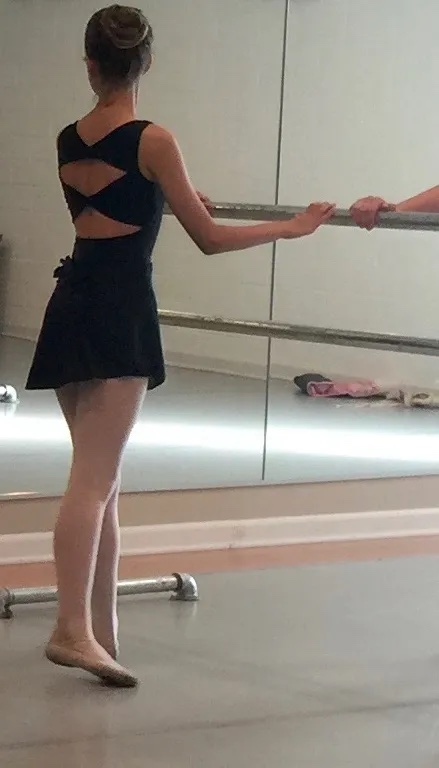
Mirror Meditation, Part 1:
A Ballet Class
January 29, 2016
By Wendy Atwell
Sixteen sets of eyes alight upon the mirror and it gives back to them their reflections, the instant gratification of their presence, the fulfillment of the promise that science makes to them, with light, refraction and the miracle of the eye. In this exchange there forms a loop or volley back and forth in which the giver is the receiver, and vice versa. The animate enlivens the inanimate. Like a canvas or a screen, their images dance across its breadth, and the instantaneous reflections disappear along the infinite, ever extending scroll of time. This crux of space and time, this tool that plays out the action in the room, it’s less a reflecting pool of vanity than a professional, necessary aid in the profession of dance.
The dancer depends on the mirror to stand in for her audience until the moment occurs when she is on stage performing. Until then, the eyes on her are only her own along with her fellow dancers’ eyes, and her ballet master’s eyes. She is reliant on its presence to feed her information about her carriage, presentation, and form. How many times has the mirror reflected back a body rising up out of itself, shoulders thrust back, arms adjusted to display grace. Hands and fingers make the tiniest of alterations. The fine-tuning of the port de bras, the strengthening of a leg, the springing of a jump, an energetic jumble of positions.
Behind those sixteen gazes there lies a swirl of emotions, like a tempest, the stirring of these sixteen spirits. They’re on their tiptoes, reaching for art, which is set up on the highest shelf of their imaginations as the teacher pushes them up, up, up towards their goal. Insecurities, lack of confidence, and fear nip at the beribboned ankles, but they are so sturdy on their toes. These tiny appendages channel the entire body’s weight and immense anxiety, grounding it into the rubber floor where it slips around with a whish and a whir to be rushed off in the haste of desire for improvement.
The gaze is a compulsory behavior built into the dancer’s practice. She returns to the mirror is like an oracle, every day, building with every glance her repertoire, recording incremental improvements that she solidifies with intuition, acquiring secret inner knowledge of what the mirror tells her. Each dancer has her own relationship with the mirror; the mirror never tells dancers the same thing, for what each dancer sees gets colored by storm behind her gaze, the light of her persona shines upon the image either to clarify or cloud its message.
When mirrors get used as tools, a universal permission exists that allows the users’ gazes to go forth openly. There’s no need for furtiveness or stolen glances. The mirror awaits their gazes like a field of wildflowers. Each glance is a innocent pluck from its bounty, these gazes are licensed by art’s higher purpose, not the audacious drive of vanity.
The dancer depends on the mirror to stand in for her audience until the moment occurs when she is on stage performing. Until then, the eyes on her are only her own along with her fellow dancers’ eyes, and her ballet master’s eyes. She is reliant on its presence to feed her information about her carriage, presentation, and form. How many times has the mirror reflected back a body rising up out of itself, shoulders thrust back, arms adjusted to display grace. Hands and fingers make the tiniest of alterations. The fine-tuning of the port de bras, the strengthening of a leg, the springing of a jump, an energetic jumble of positions.
Behind those sixteen gazes there lies a swirl of emotions, like a tempest, the stirring of these sixteen spirits. They’re on their tiptoes, reaching for art, which is set up on the highest shelf of their imaginations as the teacher pushes them up, up, up towards their goal. Insecurities, lack of confidence, and fear nip at the beribboned ankles, but they are so sturdy on their toes. These tiny appendages channel the entire body’s weight and immense anxiety, grounding it into the rubber floor where it slips around with a whish and a whir to be rushed off in the haste of desire for improvement.
The gaze is a compulsory behavior built into the dancer’s practice. She returns to the mirror is like an oracle, every day, building with every glance her repertoire, recording incremental improvements that she solidifies with intuition, acquiring secret inner knowledge of what the mirror tells her. Each dancer has her own relationship with the mirror; the mirror never tells dancers the same thing, for what each dancer sees gets colored by storm behind her gaze, the light of her persona shines upon the image either to clarify or cloud its message.
When mirrors get used as tools, a universal permission exists that allows the users’ gazes to go forth openly. There’s no need for furtiveness or stolen glances. The mirror awaits their gazes like a field of wildflowers. Each glance is a innocent pluck from its bounty, these gazes are licensed by art’s higher purpose, not the audacious drive of vanity.